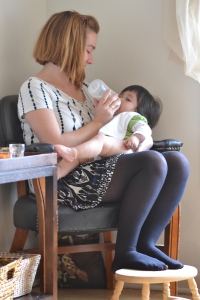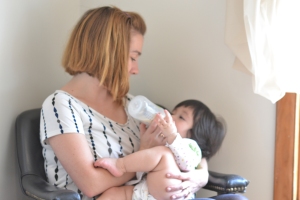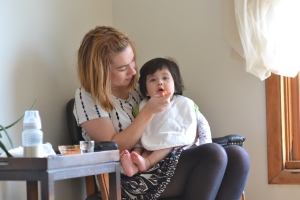
At the center, coming together for mealtime provides an opportunity for connecting and leisurely enjoying our time together- refueling not only the body, but our relationships. Until a child is able to come to the table, you’ll find her secure in the arms of her Primary Caregiver – even the maturing baby sitting up on her own.

While individual one-on-one mealtimes may take longer than feedings by weaning tables or high chairs in getting the food down, the additional time spent provides not only physical replenishment, but also generates the social and emotional refueling necessary for a child to embark on individual free play and discovery. In the long run, this frees up the caregiver to be able to attend to other children during uninterrupted individual physical care routines with the same full presence and attention.
Lap feeding a more mobile infant, however, can sometimes be awkward and messy as the child attempts to participate more in her own care. Fortunately, the environment can be prepared in a way that enables both adult and baby to be most comfortable during this time together.
Let’s revisit this photo shared earlier…. what do you notice about the arrangement?
Lap feeding can be a new experience for the adult as well as for the infant. In order for the child to feel comfortable with the arrangement, the adult must be comfortable.
Before jumping in, consider these 5 Tips to Support Laptime Meels with Babies:
1. Find a comfortable adult chair with arms. Arm rests allow the adult to comfortably rest while supporting the lap fed baby. Rocking chairs are avoided in preference for a secure, stationary base- allowing for the infant to concentrate on the meal rather than the motion.
2. The small step stool provides the height needed for a more horizontal lap area. The adult’s comfort and sense of security is translated to the child. Without the stool, the area may be positioned more at an angle causing both adult and child to tense as they work against gravity.
3. The adult is careful to wrap her arm around the child in a gentle yet firm way. Be careful not to accidentally pin the child’s arm to your side. The baby has free movement of both her hands which she may use to explore, participate or soothe during your time together.
4. Before transitioning your baby to eat, prepare the environment ahead of time. A nearby tray contains all mealtime items including food in glass bowls, water in a clear infant size cup, warmed bottle, metal infant spoon, and washcloths for hand washing. The child can see the meal before her and can anticipate what is to come. Together with her caregiver she will communicate and help regulate her body needs.
5. The child is positioned in a way where she can connect with the meal process and with her Primary Caregiver. They are easily able to make eye contact and communicate verbally and nonverbally during their time together. Fully present and in tune with her baby, the adult is able to understand when the child cues that she is finished eating or in need of more.
If you are wanting to be together with your baby during meal times, you might want to ditch the highchair. The lap arrangement makes it easier for adult and child to connect during their time together during feedings. This connection fuels not only the chid’s body, but also fuels the relationship between child and adult. Both adult and child benefit from this leisurely meal together- refueled to continue their daily activities and responsibilities independently when they part.



Comments